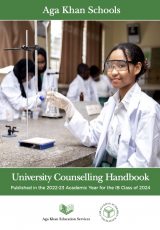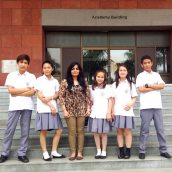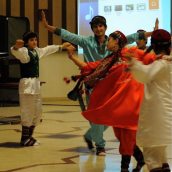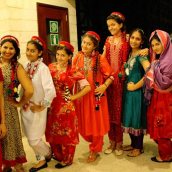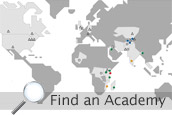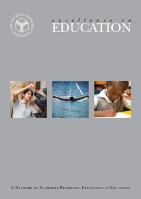Building diversity and pluralism at the Academies
“With regard to pluralism, it has been our experience that in a very large number of countries in Europe, in Asia, in Africa, in the Middle East, and elsewhere, the failure of different peoples to be able to live in peace amongst each other has been a major source of conflict. Experience tells us that people are not born with the innate ability nor the wish to see the Other as an equal individual in society. Pride in one’s separate identity can be so strong that it obscures the intrinsic value of other identities. Pluralism is a value that must be taught.”
– His Highness the Aga Khan, Peterson Lecture, 18 April 2008
The programme works toward the broader mandate of the Aga Khan Academies to educate future leaders with a pluralistic sensibility. It began as a pilot at the Academy in Mombasa in 2011. Small cohorts of students have been recruited each year to come to Mombasa from remote areas of Tajikistan, where the Aga Khan Development Network has a well-established presence.
Growing and learning through experiencing diversity
The Tajik students who have moved to the Academy in Mombasa have worked hard to transition and adjust and have grown as individuals and as global citizens through their time at the Academy.
“It has helped me to be more open-minded and look at the world from different perspectives,” says 17-year-old Alisher Amonbekovich. His peer Zarina Mamadbekova agrees, saying that she “grew up in every angle possible” during her time at the Academy. Anzhela Mirzoeva, now in year 9, feels the same way. “My perspective towards many things has changed. I see people and society in a different way.”Friends at the Aga Khan Academy MombasaThe Tajik students’ Kenyan and Tanzanian counterparts at the Academy in Mombasa appreciate the addition of their unique perspective that enriches the overall learning environment. Ashley Mutei of year 10 feels inspired by the Tajik students’ “commitment to give back to their country”, and appreciates how deeply they value the quality education they are receiving at the Academy. While discussing her Tajik roommates in the residences, Anmol Rajpar of year 10 adds that she admires “their ability to adjust to all kinds of situations easily despite being so far away from home” and thus feels motivated to be more adaptable herself. Tajik dancingDiverse perspectives account for fruitful learning experiences both inside and outside the classroom by widening one’s horizon. A Kenyan teacher at the Aga Khan Academy Mombasa, Susan Abuto, taught the Tajik students humanities and enjoyed their contributions to classroom discussions on the Silk Road. “They brought conceptual ideas to life by sharing real-life examples from home. The Silk Road trade routes through the Pamir Mountains [in Tajikistan] induced some exciting exchanges as the Tajiks related their own experiences at the mountains. During cultural celebration events, the Tajik students danced to their traditional musical instruments, which we had also touched upon in our unit on the Silk Road and was a new encounter for most students and teachers here at the Academy,” explains Susan.
Programme expansion
The Academies use a rigorous process to identify talented and highly motivated students who have the leadership potential to ultimately make a difference in their countries of origin. The selection process uses a series of assessments that cover a range of abilities and aptitudes, including leadership, resilience, and the ability to respond constructively to actual social problems.
Following an extended pre-departure orientation process, the selected students are integrated into the secondary school at one of the Aga Khan Academies. The education they receive empowers them to realise their potential and expand their view of the world while at the same time adding to the cultural and linguistic diversity of the wider student body.
First cohort at AKA HyderabadThe current academic year witnessed an important expansion of the programme, with seven students from Tajikistan and five students from Afghanistan arriving at the Aga Khan Academy in Hyderabad, India.Faraan Mithani, the International Programmes Manager for the Aga Khan Academies, has been involved in the expansion of the programme to different territories and Academy locations since he joined the project in 2014. “A programme of this nature is unprecedented,” he says, “we are unaware of others doing anything similar.”
The scope of the programme is anticipated to expand further. Faraan elaborates, “While we are currently working with Afghanistan and Tajikistan because we have identified them as two countries where access to quality education is limited, we aim to expand this programme to other countries that share this challenge. We hope that with increased funding, we will also be able to recruit a larger number of students to benefit from this programme.”
Putting pluralism into practice
Faraan explains that the vision of the programme to put pluralism into practice can be difficult to realise. “Pluralism and diversity can be challenging to embrace at the outset,” he notes. He believes that an integral component of pluralism is developing tolerance. “Accepting difference is the key element to nurturing a global conscience. A programme of this nature allows individuals to develop this global outlook by exploring communities, cultures, and religions different from their own. The result is an enriching life experience as students go beyond just acknowledging the existence of multiple perspectives but learn to actually embrace them,” says Faraan.
Students presenting at the Academy in HyderabadThe new Afghan and Tajik students have found the environment at the Academy in Hyderabad exciting and challenging. The varying accents, the spicy food and the extremely warm climate are a few of the differences to which they need to adjust. Despite these challenges of adapting to a new place and a different culture, the students are positive. “Life itself is a challenge and we are responsible to use these challenges to make ourselves better,” explains Arzou. “I got the chance to come here and get familiar with lots of cultures, and the best thing for me is the pluralism.”Sharing Tajik culture in MombasaPluralism is an important notion for all students in the programme and at the Academies. By increasing diversity in the student body at the Academies, the programme enriches the environment in which all the students live and learn. From culture nights to assemblies, students are given many opportunities to expose themselves to new cultures and new ideas while sharing their own culture and heritage. “This is a good chance for us to know about other cultures,” says Zarnisso Tolibshoeva, another student at the Academy in Hyderabad. The exchange of knowledge is mutual, with the entire student body benefiting from the process of living and learning amongst others with different backgrounds and worldviews.
The Academies focus attention on supporting the Tajik and Afghan students in the deepening of their knowledge and awareness of their own histories and cultures so they will be prepared ultimately to contribute to the development of their home countries.
Rahima Khallili is the Academy Fellow in Hyderabad who provides support to the Afghan students in Hyderabad. She came to the Academy from Kabul with the first cohort of students, and supports them as they get acculturated to the Indian context. Rahima is an important role model for the students. She describes the enjoyment she finds in seeing the cooperation amongst students from very different cultural backgrounds at the Academy. “It’s amazing seeing different people from different cultures working together as a community,” she shares. “It reminds you that life is very beautiful.” “When the kids come here,” she explains, “their minds and behaviour totally change… they are more global, more creative… it’s an amazing experience.”
By Jahaan Pittalwala, with Haifa Badi-Uz-Zaman
Newsletter readers please click here to return to the newsletter (browser version)
publications
